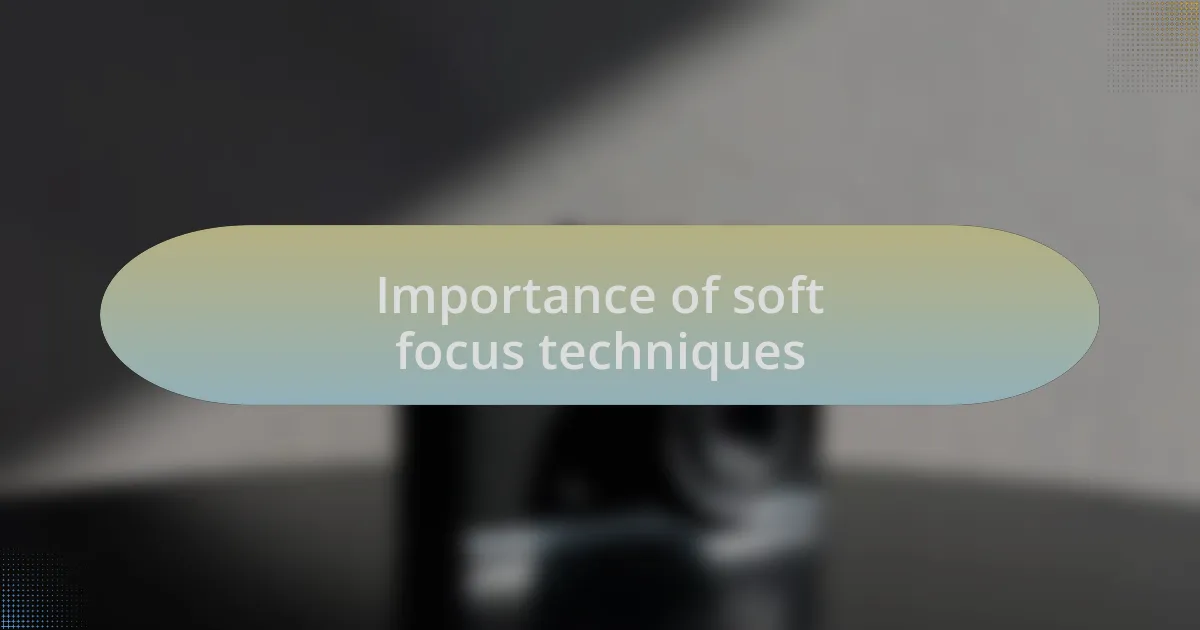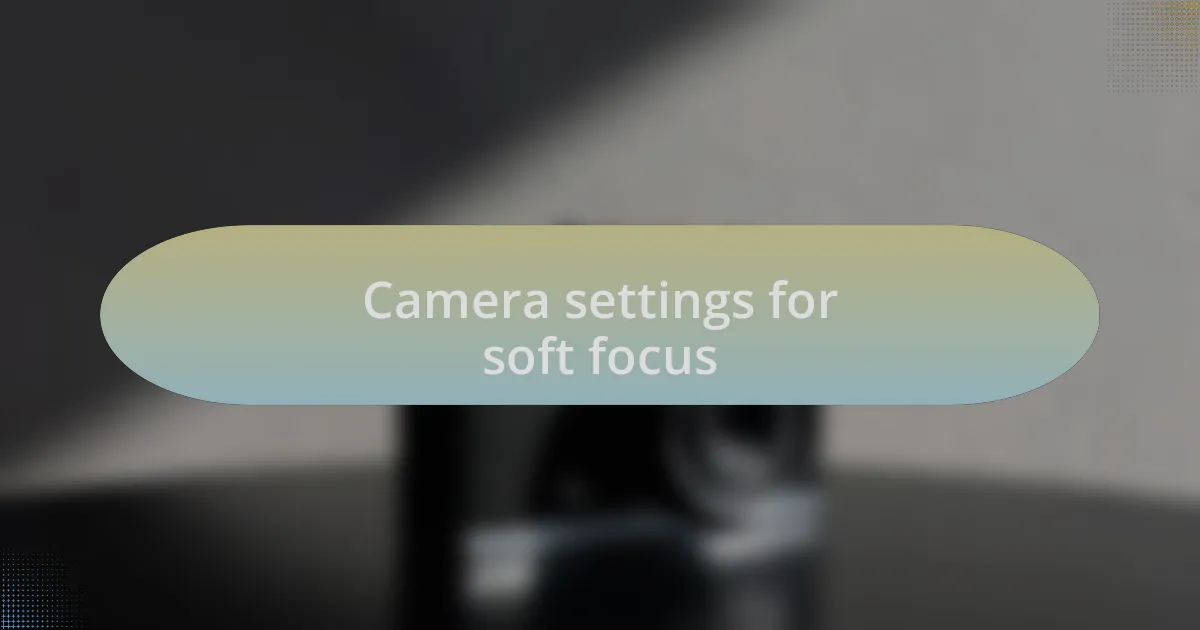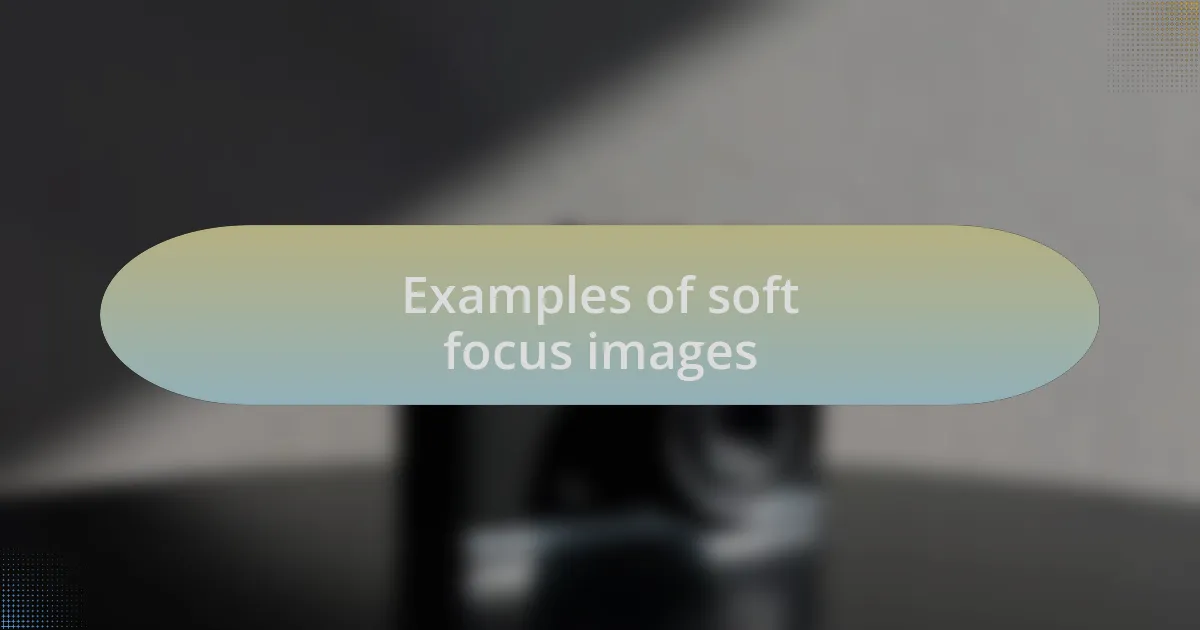Key takeaways:
- Soft focus creates a dream-like quality in images, enhancing mood and evoking emotions that sharp details may overlook.
- It’s achieved through various methods, including wide apertures, slower shutter speeds, and the use of filters, allowing photographers to control depth of field and light diffusion.
- Soft focus is effective in directing viewer attention and can transform imperfections into nostalgic visuals, enhancing storytelling in photography.
- Examples of soft focus include bridal photography, landscape moments during golden hour, and portraits that emphasize emotional connection and serenity.

Understanding soft focus in photography
Soft focus in photography is a technique that intentionally blurs the details in an image to create an ethereal, dream-like quality. I remember my first encounter with it during a portrait shoot; the model asked for a softer look to enhance her delicate features. Seeing the transformation made me realize how soft focus can evoke emotions that sharp details sometimes cannot.
This technique can be achieved through various methods, such as using special lenses or filters, or even in post-processing. Have you ever noticed how a soft-focused image can bring out feelings of nostalgia? It’s fascinating how something as simple as a blurred edge can change the mood of a photograph. Personally, I often experiment with soft focus in landscapes, where the gentle blending of colors can mimic the feel of a misty morning.
Understanding the interplay between light and softness is crucial to mastering this look. I find that natural light, particularly during the golden hour, enhances the effect beautifully. Have you ever walked through a fog and felt how it softens the world around you? That’s the magic of soft focus—capturing that moment and letting it linger in the viewer’s mind.

Importance of soft focus techniques
Soft focus techniques are vital in photography because they allow for the creation of a specific mood that can deeply resonate with viewers. One time, while photographing a couple during their engagement shoot, I opted for a soft focus effect to enhance the tenderness of their affection. The resulting images exuded warmth and intimacy, showing how a gentle visual style can evoke feelings of love and connection that stark clarity might have overshadowed.
I often find that the importance of soft focus lies in its ability to direct the viewer’s attention. During a recent landscape shoot, I used soft focus to highlight a solitary tree set against a vibrant sunset. The blurred surroundings drew the eye to the tree’s intricate details, illustrating how this technique can be a powerful storytelling tool. Have you ever felt transported to a different world simply because of how an image made you feel? That’s the beauty of soft focus—it’s not just about aesthetics; it’s about eliciting emotional responses.
Moreover, soft focus techniques can also serve as a forgiving approach when tackling imperfections—in both subjects and settings. I remember once photographing an older building that was showing signs of wear and tear. By employing a soft focus, I softened the harsh realities while still capturing the structure’s character, transforming what might have been a less appealing image into a nostalgic piece reminiscent of a bygone era. Isn’t it fascinating how a little blur can breathe new life into our perceptions?

Camera settings for soft focus
To achieve that dreamy soft focus look, I often adjust my aperture settings. Opening up my lens to a wide aperture, like f/2.8 or even lower, not only allows more light in but also creates a shallow depth of field. This means only the subject remains sharp while the background softly fades away, making the image feel more ethereal. Have you ever noticed how portraits shine when the background melts into a gentle blur?
Additionally, I play with my shutter speed to complement the soft focus effect. Slower shutter speeds can introduce a slight motion blur, which I find particularly enchanting in nature photography. During one memorable shoot of a flowing waterfall, I intentionally slowed my shutter speed. The water became a silky cascade, while the surrounding environment held that delicate softness. This approach not only captures movement but also enhances the serene atmosphere of the scene.
Lastly, I sometimes utilize filters to aid in softening my images. A diffusion filter can gently spread light across the frame, creating a beautiful, hazy quality that enhances the dreamlike vibe. I remember experimenting with one during a sunrise shoot, where the light was soft enough already. The filter added a touch of magic, enveloping everything in a warm glow. Have you ever tried using filters in your photography? They can transform your approach in unexpected ways!

Examples of soft focus images
One captivating example of soft focus images is in bridal photography. I recall a wedding I shot where the bride was surrounded by flowers. As I adjusted my aperture to f/2.8, the blooms became a gentle, colorful haze behind her. That dreamy effect not only highlighted her beauty but also made the scene feel romantic and timeless. How often have you noticed how soft focus can elevate the emotional tone of an image?
Another great instance is in landscape photography, particularly during golden hour. On a trip to the mountains, I captured a serene lake scene where the nearby trees were slightly blurred. This soft focus drew attention to the shimmering water, creating a tranquil, almost surreal atmosphere. Have you ever experienced the magic of shooting at that perfect moment when light and soft focus blend seamlessly?
Portraits can also exemplify soft focus beautifully. I remember photographing my friend in a sun-dappled park, using a soft focus technique that made her features dreamy and inviting. The background held just enough blur to remain interesting without stealing attention from her radiant smile. Isn’t it fascinating how soft focus can evoke such emotion and add a storytelling element to our images?